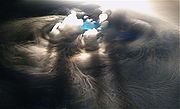
Dry ice
Did you know...
SOS Children have produced a selection of wikipedia articles for schools since 2005. A quick link for child sponsorship is http://www.sponsor-a-child.org.uk/
Dry ice is the genericized trademark for solid carbon dioxide. It is commonly used as a versatile cooling agent. Dry ice sublimes, changing directly to a gas at atmospheric pressure. Its sublimation and deposition point is -78.5 °C (-109.3 °F). Its enthalpy of sublimation (ΔHsub) @ -78.5 °C (-109.3 °F) is 199.0 kJ/kg (245.5 BTU/lb). The low temperature and direct sublimation to a gas makes dry ice a very effective coolant, since it is colder than ice and leaves no moisture as it changes state.
History
In 1835 the French chemist Charles Thilorier published the first account of dry ice. Upon opening the lid of a large cylinder containing liquid carbon dioxide he noted much of the carbon dioxide rapidly evaporated leaving solid dry ice in the container. Throughout the next 60 years, dry ice was observed and tested by scientists.
Manufacture
Dry ice is readily manufactured:
- Gases containing a high concentration of carbon dioxide are produced. Such gases can be a byproduct of some other process, such as producing ammonia and nitrogen from natural gas, or large-scale fermentation.
- Carbon dioxide-rich gas is pressurized and refrigerated until it changes into its liquid form.
- The pressure is reduced. When this occurs some liquid carbon dioxide vaporizes, and this causes a rapid lowering of temperature of the remaining liquid carbon dioxide. The extreme cold makes the liquid solidify into a snow-like consistency.
- The snow-like solid carbon dioxide is compressed into either small pellets or larger blocks of dry ice.
Dry ice is typically produced in two standard forms: blocks and cylindrical pellets. A standard block weighing approximately 30 kg is most common. These are commonly used in shipping, because they sublime slowly due to a relatively small surface area. Pellets are around 1 cm in diameter and can be bagged easily. This form is suited to small scale use, for example at grocery stores and laboratories. Dry ice is also inexpensive; it costs about US$2 per kilogram.
Applications
Dry ice is commonly used to package items that need to remain cold or frozen, such as ice cream, without the use of mechanical cooling. In medicine it is used to freeze warts to make removal easier. In the construction industry it is used to loosen floor tiles by shrinking and cracking them, as well as to freeze water in valveless pipes to allow repair. In laboratories, a slurry of dry ice in an organic solvent is a useful freezing mixture for cold chemical reactions.
Dry ice can also be used for making ice cream.
Dry ice is also used as a source of carbon dioxide. It can be used to carbonate water and other liquids such as beer. It can be used as bait to trap mosquitoes and other insects
When dry ice is placed in water sublimation is accelerated, and low-sinking dense clouds of fog are created. This is used in fog machines at theaters, discoteques and nightclubs for dramatic effects.
Dry ice blasting
One of the largest alternative uses of dry ice is blast cleaning. Dry ice pellets are shot out of a nozzle with compressed air. This can remove residues from industrial equipment. Examples of materials being removed include ink, glue, oil, paint, mold and rubber. Dry ice blasting can replace sandblasting, steam blasting, water blasting or solvent blasting. The primary environmental residue of dry ice blasting is the sublimed CO2, thus making it a useful technique where residues from other blasting techniques are undesirable.




